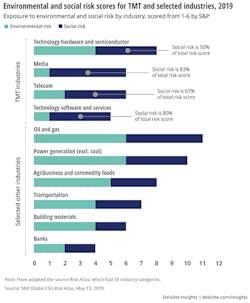Latest from Network Reliability/Testing & Assurance/Cybersecurity/Safety
It’s More Complicated Than You Think
How TMT Industries Can Tackle ESG
When it comes to Environmental, Social, and Governance (ESG), environmental risk typically gets most of the attention. But the social risks of Technology, Media and Telecom (TMT) companies could matter even more to investors in the long run.
Companies are working hard on ESG issues because it’s the right thing to do. Their efforts in this area can act as core growth drivers. They’re also increasingly important to investors.
Funds invested according to ESG guidelines have doubled in 2021, growing 3 times faster than non-ESG assets. They are predicted to grow to US$53 trillion by 2025, or almost 40% of all investments globally.
But investors are focusing more on environmental considerations than social. According to a 2020 survey of CFA Institute members, more were taking environmental risk into account for investment analysis or decisions than social, and that percentage was rising faster compared to a similar survey in 2017.
There are many groups that provide ESG risk scores for investors. Figure 1 shares one from the S&P that illustrates which industries have significant exposure to environmental and social risks according to a 2019 S&P Global ESG Risk Atlas report. (While the data is from 2019, industry-level risks have not altered materially since then.)
S&P Global’s environmental risks include greenhouse gas emissions; sensitivity to extreme weather events; sensitivity to water scarcity; waste, pollution, and toxicity; and land use and biodiversity.
Thankfully, many TMT companies have recently improved their environmental risks in the following ways:
- Hyperscale cloud companies are focusing on decarbonization.
- Chip companies are designing semiconductor fabs that are more energy efficient and use less water.
- Tech devices at the end of their lives are increasingly being recycled.
- Media companies are reducing the carbon footprint of video streaming.
The industries’ efforts around reducing environmental risks are paying off. A 2021 academic study on the sector by Jonathan Koomey and Eric Masanet showed that tech and telecom companies are much more efficient in their power use than is generally believed. Indeed, TMT companies have more to do. But given the relative size of social scores, TMT companies should think about how to do even better on social risks that include: human capital management, changing consumer or user preference, demographic changes, safety management, and social cohesion.
Indeed, TMT companies have more to do. But given the relative size of social scores, TMT companies should think about how to do even better on social risks that include: human capital management, changing consumer or user preference, demographic changes, safety management, and social cohesion.
According to S&P Global, social factors present a host of risks for TMT industry subsectors.
- Tech Software and Service: Social risks include privacy and data security concerns, but also risk of increased regulation, and lack of gender equality and diversity in the workforce.
- Hardware and Semiconductors: Social risks are led by concerns over labor practices, but the industry’s supply chain is another source of risk, as it relies on resources mined in geopolitically unstable areas, and the concentration of manufacturing in East Asia exposes it to risk from geopolitical concerns and trade disputes.
- Media: Social risks are data privacy and security, regulation, social media activism, IP theft, and key person risk (media companies often rely on a single star actor, singer, or director).
- Telecoms: Social risks tend to come from demographic trends, but also include fears of overuse, misinformation, data security and network reliability, as well as issues around labor forces.
3 Suggestions
What does all this mean for telecom providers? Below are 3 suggestions for leaders across the industry:- Take it piecemeal and start now: Some social risk scores are relatively harder for an industry to improve on, but others are easier. Every improvement helps reduce risk: For example, telecom companies could invest more on data security and privacy, which would benefit customers and lower their social risk score at the same time.
- Diversity will move the needle: More diverse workforces and/or having more diverse content can be some of the fastest and most controllable levers TMT can use to reduce risk scores.
- Winning the war for talent: Every industry is struggling to attract and retain the right talent. Reducing social (and environmental) risks make industries and companies more attractive to employees, especially those critical younger employees, for whom ESG issues matter more than other demographics.
The best guidance for companies is to continue striving to improve both areas at the same time. Although social risk scores for the industry are as large or larger than environmental risk scores, companies don’t need to choose one or the other. Investors, stakeholders, shareholders, regulators, and journalists, all pay attention—perhaps even more attention—to environmental issues and risks.
Remember, improving social risk scores cannot come at the cost of a reduced focus on the environment.
Coauthored by Duncan Stewart and Ariane Bucaille
Duncan Stewart is Director of Research for the Technology, Media, and Telecommunications (TMT) industry for Deloitte Canada. He presents regularly at conferences and to companies on marketing, technology, consumer trends, and the longer-term TMT outlook. For more information, visit www.deloitte.com, and follow Duncan on Twitter at https://twitter.com/dunstewart.
Ariane Bucaille is the Global Technology, Media, and Telecommunications (TMT) industry leader. In addition, she is a partner in Deloitte France, where she leads the TMT practice. She has 20+ years of experience and is a chartered and certified public accountant. For more information, please email [email protected], or visit www.deloitte.com, and follow Ariane on LinkedIn: https://www.linkedin.com/in/ariane-bucaille-8016a73.






